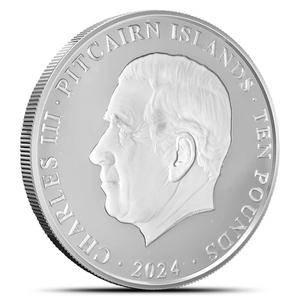The Pitcairn Islands is a non-sovereign British overseas territory in the Pacific Ocean. Having a population of fewer than fifty people, the territory has no need for local coinage and uses the New Zealand dollar as a medium of exchange. Pitcairn Islands began issuing its first commemorative coins in 1988. Though the Pitcairn Islands dollar is not a true currency in the strict sense of the word and is not used as a circulation coinage, it can be lawfully exchanged as tender and is considered a variety of the New Zealand dollar (although it is not legal tender in New Zealand). The Pitcairn Islands dollar exists only because of the coin collecting market, which provides a major staple for the tiny island nation.
The coins are struck by various foreign mints and use internationally popular formats, such as the very large five troy ounces (5oz) of silver size.
This design is the second release in the Marine Life Series issued by the Tower Mint for the Pitcairn Islands, and features the Lemonpeel Angelfish.
The mint says about it:
The Pitcairn Islands Marine Reserve is a rich and protected ecosystem in the South Pacific, renowned for its diverse marine life. Among its colorful inhabitants, the lemonpeel angelfish (Centropyge flavissima) stands out as a particularly vibrant species, drawing attention for its striking appearance and unique behavior.
The lemonpeel angelfish is easily recognizable by its vivid yellow body, adorned with a bright blue ring around the eyes and blue edges on its fins. Reaching about 10 cm (4 inches) in length, this small fish displays the typical bold coloration that makes angelfish so captivating to marine enthusiasts. Its vibrant coloring serves both as camouflage among coral reefs and as a warning to potential predators, as it can be aggressive when defending its territory.
Lemonpeel angelfish thrive in the coral reefs of the Pitcairn Islands Marine Reserve, typically residing in depths between 5 and 25 meters. Their habitat consists of rocky crevices and coral formations, where they find shelter and food. These angelfish are omnivores, feeding on a mix of algae and small invertebrates such as sponges and tunicates. Their feeding habits play an important role in maintaining the balance of the coral reef ecosystem, as they help to control algae growth.
Though solitary by nature, lemonpeel angelfish are known to exhibit curious and territorial behavior, often engaging in displays of dominance to protect their space on the reef. Their vibrant colors and distinctive behaviors make them a favorite among divers and marine photographers. | 




 Buy this online from JM Bullion
Buy this online from JM Bullion
 Search for Pitcairn Islands: Silver Five Ounces 2024 Lemonpeel Angelfish on eBay
Search for Pitcairn Islands: Silver Five Ounces 2024 Lemonpeel Angelfish on eBay 
